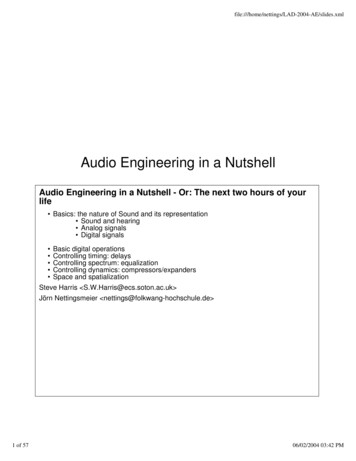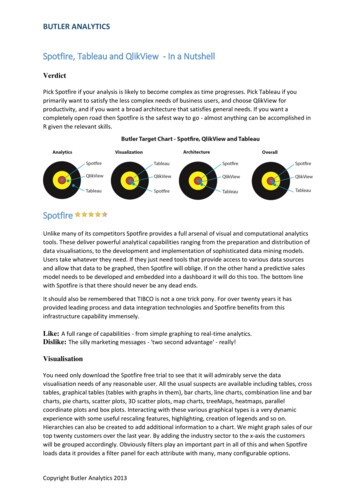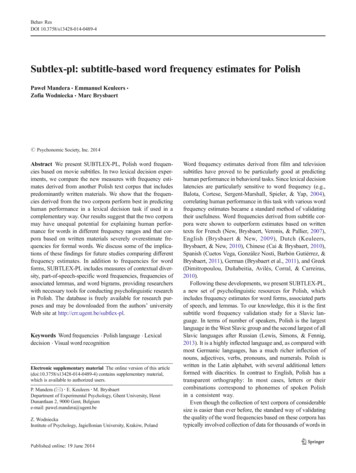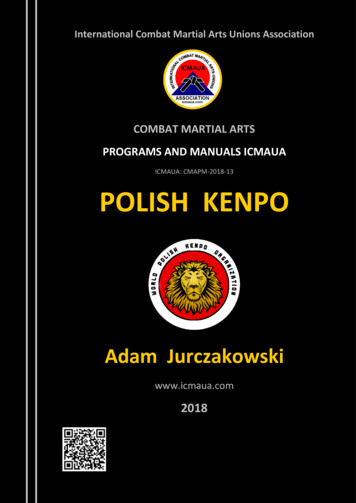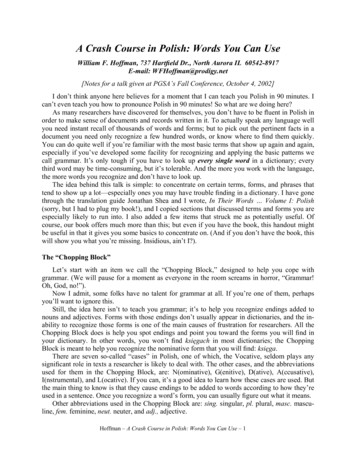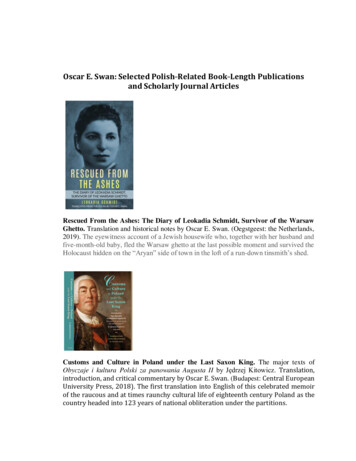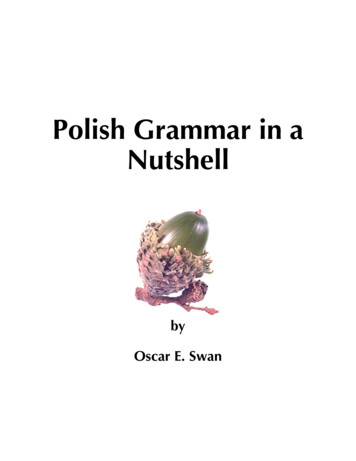
Transcription
PolishGrammar in aNutshell Oscar E. SwanUniversity of Pittsburgh2003Information on Polish sounds and grammarwhich should be mastered by theintermediate-level student of thelanguage.
POLISH GRAMMAR IN A NUTSHELL540
POLISH GRAMMAR IN A NUTSHELLCONTENTSThe Polish Alphabet and Sounds 5Notes on Spelling and Pronunciation 6Sound Changes 8Nouns 9Noun Gender 9Cases and Case Use 11Noun Phrases 13Regular Noun Endings 15Distribution of Endings 16Noun Endings Depending on the Hard-Soft Distinction 17Noun Declensions 19Days of the Week 23Compass Directions 23Months 24Pronouns 24Personal Pronouns 24Possessive Pronouns 26Demonstrative and Relative Pronouns 27Intensive Pronoun 28Reflexive Pronoun 28Distributive Pronoun 29Adjectives 30Adjective Declension 30Adjective-Noun Order 30Comparison of Adjectives 31Adjective Opposites 31Adverbs 33Comparison of Adverbs 33Non-Adjectival Adverbs 35Numerals 37Cardinal Numerals 37Compound Numbers 38Declension of Cardinal Numerals 38541
POLISH GRAMMAR IN A NUTSHELLCollective Numerals 41Reified Numerals 42Indefinite Numerals 42Counting People 42Ordinal Numerals 43Time of Day 43Dates, Years, Expressing ‘How Old’ 44Prepositions 45Prepositions Arranged According to Case 46Prepositions Expressing 'at', 'to', 'from' 47Expressions of Time 47Polish Translations of 'For' 48Conjunctions 50Verbs 51Finite Verb Categories 53Present Tense 53Summary of Verb Classes 56Imperative 57Past Tense 58Future Tense 60Perfective and Imperfective Aspect 60Verbs of Motion 62Conditional Mood 63Participles and Gerunds 64Passive Voice 66Impersonal Verbs 67Reflexive Verbs 68Important Sentence Constructions 71Constructions with the Infinitive 71Modal Expressions 71‘Introducing’ Sentences 71Expressing 'There Is' 72Predicate Nouns and Adjectives 72Yes-No Questions 72Negation 72Word Order 73Sentence Intonation 73542
POLISH GRAMMAR IN A NUTSHELLTHE POLISH ALPHABET AND SOUNDSHere is the Polish alphabet: a, à, b, c, ç, d, e, , f, g, h, I, j, k, l, , m, n, ƒ, o,ó, p, r, s, Ê, t, u, w, y, z, ê, .SOUND VALUES OF THE LETTERSLETTERAPPROXIMATEENGLISH SOUNDEXAMPLEafathertak thus, so, yes, raz onceàdomesà they are, wà snakeThe sound à is pronounced like om, except that the lips or tongue are notcompletely closed to pronounce the m, leaving a nasal resonance instead.bbigbok side, aby so thatbibeautifulbieg course, run, race, tobie to youcfitsco what, noc night, taca traychhallchata cottage, ucho ear, dach roofThe sound of ch is much raspier and noisier than English h.cicheekciasto cake, cicho quietczchalkczas time, gracz player, t cza rainbowçcheekchoç although, niçmi thread (Inst. pl.)The letters ç and ci- are pronounced the same. The combination ci- is usedbefore a vowel. The letter c before i is pronounced like ç/ci-. The sound ofç/ci-, pronounced with the mouth in the position of English )y), is differentfrom that of cz, pronounced with the mouth in the position of English "r".ddodata date, lada counterdzoddscudzy foreign, wodze reinsdzijeansdziadek grandfather, ludzie peopledêjeanswiedêma witch. ludêmi people-Instr.pl.d jawd ez jazz, rad a rajahThe letters dê and dzi- are pronounced the same. The combination dzi- isused before a vowel. The letters dz before i are pronounced like dê/dzi-.The sound of dê/dzi-, pronounced with the mouth in the position of English"y", is different from that of d , pronounced with the mouth in the position ofEnglish "r".eeverten this (masc.), ale but, Edek Eddie senseg Ê goose, t skniç long forThe sound is pronounced like em, except that the lips or tongue are notcompletely closed to pronounce the m, leaving a nasal resonance instead. Atthe end of a word, the letter is normally pronounced the same as e:naprawd "naprawde".ffeltfarba paint, lufa rifle-barrel, blef bluffggetguma rubber, noga leg, footgibug yougie da stock-market, magiel manglehhallhak hook, aha aha!543
POLISH GRAMMAR IN A NUTSHELLPronounced the same as ch (see above), the letter h appears mainly in wordsof foreign origin.icheeklist letter, ig a needlejyou, boyjak as, raj paradise, zajàc harekkegkot cat, rok year, oko eyekilike youkiedy when, takie such (neut.)llovelas forest, dal distance, fala wave wag, bow eb animal head, by he was, o ówek pencilmiharm youmiara measure, ziemia earthmmothmama mama, tom volumennotnoc night, pan sir, ono itnicanyonnie no, not, nigdy neverƒcanyonkoƒ horse, haƒba disgraceThe letters ƒ and ni- are pronounced the same. The combination ni- is usedbefore a vowel. The letter n before i is pronounced like ƒ/ni-.opokepot sweat, osa wasp, okno windowótootból pain, o ówek pencilThe letter ó is pronounced the same as u.ppuppas belt, strap, apa paw, cap billy-goatpistop youpiana foam, apie he catchesrarriba (Span.)rada advic, kara punishment, dar giftThe sound r is pronounced by trilling the tip of the tongue, as in Spanish orItalian.rzpleasurerzeka river, morze seaThe letter-combination rz is pronounced the same as ; see below.ssadsam the same (masc.), pas belt, rasa breedsisheepsiano hay, sito sieveszsharkszal frenzy, dusza sou,ÊsheepoÊ axle, kwaÊny sour, Êpi he sleepsThe letters Ê and si- are pronounced the same. The combination si- is usedbefore a vowel. The letter s before i is pronounced like Ê/si-. The sound ofÊ/si-, pronounced with the mouth in the position of English "y", is differentfrom that of sz, pronounced with the mouth in the position of English "r".ttoptam there, data date, kot catutootbut shoe, tu here, ucho earwvatwata cotton wadding, kawa coffeeyilldym smoke, ty you (sg.)zzoozupa soup, faza phaseziazureziarno grain, zima winterêazurewyraêny distinct, êle badly pleasure aba frog, pla a beachThe letters ê and zi- are pronounced the same. The combination zi- is usedbefore a vowel. The letter z before i is pronounced like ê/zi-. The sound ofê/zi-, pronounced with the mouth in the position of English "y", is differentfrom that of , pronounced with the mouth in the position of English "r".544
POLISH GRAMMAR IN A NUTSHELLNOTES ON SPELLING AND PRONUNCIATION1. The Polish alphabet has no Q, V or X, although these letters may befound in transcriptions of foreign names, and in a few borrowed words, e.g.video, pan X Mr. X.2. Polish vowels a, e, i, y, o, u (ó) are all pronounced with exactly thesame short length, achieved by not moving the tongue or the lips after theonset of the vowel, as happens, for example, in English vowel-sounds ee(knee), oe (toe), oo (boot). Only the nasal vowels are pronounced long, thelength being due to rounding the lips and pronouncing the glide "w" at theend: sà.3. Polish consonant sounds may be pronounced slightly differentlyaccording to position in a word. Most importantly, voiced consonant soundsb, d, dz, g, rz, w, z, ê, are pronounced as unvoiced sounds (p, t, c, k, sz, f,s, Ê, sz, respectively) in final position. For example, paw is pronounced "paf";chodê is pronounced "choç".voicedvoicelessbpdtdzcgkrzszwfzsêÊ sz4. The letters à and are usually pronounced like on/om or en/em,respectively, before consonants. For example, làd is pronounced "lont"; dàbis pronounced "domp"; t py is pronounced "tempy"; d ty is pronounced"denty"; and so on. Before ç and dê, and à are pronounced eƒ/oƒ: ch ç"cheƒç", làdzie "loƒdzie". Before k and g, à and may be pronounced as oor e plus the English ng sound: màka, pot ga. The vowels à and areusually denasalized before l or : zdj li "zdjeli", zdjà "zdjo ".5. The stress in a Polish word falls on the next-to-last syllable: DAR-ka,zadowolony za-do-wo-LO-ny. As these examples show, Polish syllablestend to divide after a vowel. Words in -yka take stress on the precedingsyllable: mateMAtyka, MU-zyka. The past-tense endings -yÊmy/-iÊmy,-yÊcie/-iÊcie do not cause a shift in place of stress: BY- yÊ-my.6. SPELLING RULES:a. So-called kreska consonants (ç, dê, ƒ, Ê, ê) are spelled with an acutemark only at word-end and before consonants; otherwise, they are spelled asc, dz, s, z, n plus a following i: dzieƒ "dêeƒ", nie "ƒe". Before the vowel iitself, no extra i is needed: ci "çi" to you.b. Certain instances of b, p, w, f, m are latently soft, meaning that theywill be treated as soft (in effect, as if kreska consonants) before vowels. In thespelling, they will be followed by i. Compare paw peacock, plural pawie(paw'-e) peacocks.545
POLISH GRAMMAR IN A NUTSHELLc. The letter y can be written only after a hard consonant (see below) orafter c, cz, dz, rz, sz, . The letter i after the consonants c, dz, n, s, z alwaysindicates the pronunciations ç, dê, ƒ, Ê, ê, respectively. Only i, never y, maybe written after l or j.d. The letter e is usually separated from a preceding k or g by i,indicating a change before e of k, g to k', g': jakie, drogie.e. The letter j is dropped after a vowel before i: stoj I stand but stoiszyou stand.SOUND CHANGES1. When describing word formation, some consonants are counted ashard (H) and others as soft (S):HS1S2pp'bb'ff'ww'mm't d s z nç dê Ê ê ƒ lr k grz c dzcz chszjHard consonants can soften before certain endings. For example, r goes to rzbefore the Locative singular ending -'e, as in biur-'e: biurze office (frombiuro).As noted, the consonants p, b, f, m, w at the end of a word may turn outto be soft (p', b', f', m', w', spelled pi-, bi-, fi-, mi-, wi-), when not at the endof a word; cf. paw peacock, pl. pawie.2. One often observes vowel changes within Polish words depending onwhether endings are added to them. The most important such changesinvolve an alternation between o and ó, and à, io/ia and ie, and betweene and nothing (fleeting or mobile e). These changes may be observed in thesingular and plural forms of the following nouns: stó sto y table-tables, zàbz by tooth-teeth, sàsiad sàsiedzi neighbor-neighbors, ch opiec ch opcy boy-boys,pies psy dog-dogs.546
POLISH GRAMMAR IN A NUTSHELLOUTLINE OF POLISH GRAMMARNOUNSLACK OF ARTICLES. Polish does not have elements corresponding toEnglish indefinite and definite articles a, an, the. One interprets a noun asdefinite or indefinite on the basis of context. Hence dom may be interpretedas 'a house' or 'the house'.NOUN GENDER. Polish nouns have three genders: masculine,feminine and neuter. Grammatical gender has nothing to do with naturalgender (sex). It is mainly of importance for purposes of grammaticalagreement. For example, feminine nouns require that a modifying adjectivehave 'feminine' endings, as in dobra lampa a good lamp; compare tomasculine dobry stó good table or neuter dobre drzewo good tree. Whilenames for males will be masculine in gender, and names for females will befeminine, other objects in the world are divided up according to gender inan arbitrary way. For example, nos nose is masculine in gender, and g owahead is feminine; s oƒce sun is neuter, while ksi yc moon is masculine.NOUNS STEMS. Nouns may end in a consonant or in a vowel; if in avowel, the stem of the noun, to which endings are added, is obtained bysubtracting the vowel. For example, the stem of g owa head is g ow-, whilethe stem of nos nose is nos-.MASCULINE NOUNS usually end in a consonant, for example: nosnose, stó table, hotel hotel, piec stove, mà husband. Some masculine names ofpersons end in -a, for example, kolega colleague, and even m czyzna man.Often masculine nouns show different stems before endings and when thereis no ending, as stó table, sto y tables, or mà husband, m owie husbands.PLURAL OF MASCULINE NOUNS. Masculine non-personal nounsending in hard consonants (see the Introduction) usually form the plural in-y, for example nos nosy nose(s), stó sto y table(s). One writes i after k or g:czek czeki check(s). Masculine nouns ending in soft consonants usually formthe plural in -e, for example hotel hotele hotel(s), piec piece stove(s).MASCULINE PERSONAL NOUNS often take special endings in theplural. Usually the ending is -i/y, preceded by the softening of thepreceding consonant: student studenci student(s), Polak Polacy Pole(s), and soon. With titles and relations, the ending -owie often occurs: pan panowiesir(s), profesor profesorowie professor(s), mà m owie husband husbands;brat bracia brother(s) is quite exceptional.FEMININE NOUNS most often end in -a, for example, lampa lamp,kobieta woman, krowa cow, siostra sister, mama mother, torba bag, ulicastreet. Some feminine nouns end in a soft consonant, for example, twarz face,547
POLISH GRAMMAR IN A NUTSHELLkoÊç bone, rzecz thing. A few feminine personal nouns end in -i, asgospodyni landlady. The noun osoba person is feminine in gender, whetherit refers to a man or a woman.PLURAL OF FEMININE NOUNS. Feminine nouns followapproximately the same rules as masculine nouns when forming the plural.Nouns ending in a hard consonant take -y, for example kobiety women,krowy cows, siostry sisters, torby bags. One writes i after k or g: noga nogileg(s). Feminine nouns whose stem ends in a soft consonant usually take -e,for example koleje rails, ulice streets, twarze faces, rzeczy things, koÊci bones.Some feminine nouns ending in a soft consonant take -y/i, for examplerzeczy things, koÊci bones.NEUTER NOUNS end in -o or (after soft consonants) -e, for examplemyd o soap, ko o wheel, piwo beer, morze sea, pole field, zdanie opinion.Exceptional are nouns like imi name and zwierz animal, which end in .Some neuter nouns, borrowed from Latin, end in -um, for example muzeummusuem.PLURAL OF NEUTER NOUNS. Neuter nouns form the plural in -a,for example: ko a wheels, piwa beers, morza seas, pola fields, zdania opinions.Nouns like imi and zwierz have plurals imiona names, zwierz ta animals.The plural of muzeum is muzea. The noun dziecko child is of neuter gender,even though it refers to a person. Its plural is dzieci children.SUMMARY OF NAMES FOR PEOPLE AND THEIR PLURALS.babcia grandmother, pl babcienarzeczona fiancée, pl narzeczonebrat brother, pl bracianarzeczony fiancé, pl narzeczenich opiec boy, pl ch opcyojciec father, pl ojcowieciocia aunt, pl ciocieosoba person,
POLISH GRAMMAR IN A NUTSHELL 544 Pronounced the same as ch (see above), the letter h appears mainly in words of foreign origin. i cheek list letter, ig a needle j you, boy jak as, raj paradise, zajàc hare k keg kot cat, rok year, oko eye ki-like you kiedy when, takie such (neut.)l love las forest, dal distance, fala wave wag, bow eb animal head, by he was, o ówek pencilFile Size: 296KBPage Count: 76Explore furtherLearn polish pdf - printable resources to study Polish on .www.polskidaily.euPolish Grammar in a Nutshell - Place Dauphinewww.placedauphine.netpolish grammar 18mar02 - Duke CSEEES & SEELRCwww.seelrc.org:8080A GRAMMAR OF CONTEMPORARY POLISH - The Eyethe-eye.euThe Best Resources for Learning Polish - Learn language in .www.clozemaster.comRecommended to you based on what's popular Feedback
